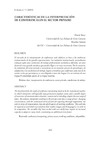Identificador persistente para citar o vincular este elemento:
https://accedacris.ulpgc.es/jspui/handle/10553/77874
| Campo DC | Valor | idioma |
|---|---|---|
| dc.contributor.author | Bovy, David Jacques | en_US |
| dc.contributor.author | Adams, Heather Mary | en_US |
| dc.date.accessioned | 2021-03-01T15:04:49Z | - |
| dc.date.available | 2021-03-01T15:04:49Z | - |
| dc.date.issued | 2019 | en_US |
| dc.identifier.issn | 2444-197X | en_US |
| dc.identifier.other | Dialnet | - |
| dc.identifier.uri | https://accedacris.ulpgc.es/handle/10553/77874 | - |
| dc.description.abstract | El mercado de la interpretación de conferencia suele definirse en base a las tendencias institucionales de las grandes organizaciones. Los intérpretes institucionales normalmente trabajan según unas condiciones de trabajo perfectamente acordadas y definidas, así como dentro de unas grandes temáticas que pueden llegar a ser muy recurrentes. Por lo contrario, los intérpretes del sector privado se encuentran en un constante proceso de aprendizaje y de adaptación a las condiciones de trabajo, lugares y temáticas que conforman cada uno de los eventos en los que participan y se ven obligados a tener dos lenguas A o un mínimo de una lengua B consolidada aparte de su lengua materna. | en_US |
| dc.description.abstract | The benchmark for the study of conference interpreting tends to be the instiutional market, in which interpreters will typically enjoy permanent employee status and a notable degree of recurrence of communicative situation, context and terminology, despite the vast range of topics. By contrast, interpreters working in the private sector face a range of ever- changing circumstances, with the contractual terms of each job requiring thorough negotiation, not only in terms of remuneration, but also of all aspects of working conditions. They will also be required to work both into and from their mother tongue and B language(s), in order to be competitive. The variables they have to deal with on a daily basis require an increased capacity to adapt on many levels, constituting an additional stress factor. | en_US |
| dc.language | spa | en_US |
| dc.publisher | Asociación Española de Lingüística Aplicada, AESLA | |
| dc.relation.ispartof | E-Aesla | en_US |
| dc.source | E-Aesla [ISSN 2444-197X], n. 5, p. 343-350 | en_US |
| dc.subject | 570112 Traducción | en_US |
| dc.subject | 570113 Lingüística aplicada a la traducción e interpretación | en_US |
| dc.subject.other | Interpretación de conferencia | en_US |
| dc.subject.other | Sector privado | en_US |
| dc.subject.other | Condiciones de trabajo | en_US |
| dc.subject.other | Conference interpreting | en_US |
| dc.subject.other | Private sector | en_US |
| dc.subject.other | Working conditions | en_US |
| dc.subject.other | Adaptability | en_US |
| dc.title | Características de la interpretación de conferencia en el sector privado | en_US |
| dc.type | info:eu-repo/semantics/Article | en_US |
| dc.type | Article | en_US |
| dc.identifier.url | http://dialnet.unirioja.es/servlet/articulo?codigo=7780425 | - |
| dc.description.lastpage | 350 | en_US |
| dc.identifier.issue | 5 | - |
| dc.description.firstpage | 343 | en_US |
| dc.investigacion | Artes y Humanidades | en_US |
| dc.type2 | Artículo | en_US |
| dc.contributor.authordialnetid | No ID | - |
| dc.contributor.authordialnetid | 1390116 | - |
| dc.identifier.dialnet | 7780425ARTREV | - |
| dc.utils.revision | Sí | en_US |
| dc.identifier.ulpgc | Sí | en_US |
| dc.contributor.buulpgc | BU-HUM | en_US |
| item.fulltext | Con texto completo | - |
| item.grantfulltext | open | - |
| crisitem.author.dept | Departamento de Filología Moderna, Traducción e Interpretación | - |
| crisitem.author.dept | GIR IDETIC: División de Traducción e Interpretación y Aprendizaje de Lenguas | - |
| crisitem.author.dept | IU para el Desarrollo Tecnológico y la Innovación | - |
| crisitem.author.dept | Departamento de Filología Moderna, Traducción e Interpretación | - |
| crisitem.author.orcid | 0000-0001-5634-8477 | - |
| crisitem.author.orcid | 0000-0001-7822-431X | - |
| crisitem.author.parentorg | IU para el Desarrollo Tecnológico y la Innovación | - |
| crisitem.author.fullName | Bovy, David Jacques | - |
| crisitem.author.fullName | Adams, Heather Mary | - |
| Colección: | Artículos | |
Visitas
318
actualizado el 13-abr-2024
Descargas
78
actualizado el 13-abr-2024
Google ScholarTM
Verifica
Comparte
Exporta metadatos
Los elementos en ULPGC accedaCRIS están protegidos por derechos de autor con todos los derechos reservados, a menos que se indique lo contrario.
